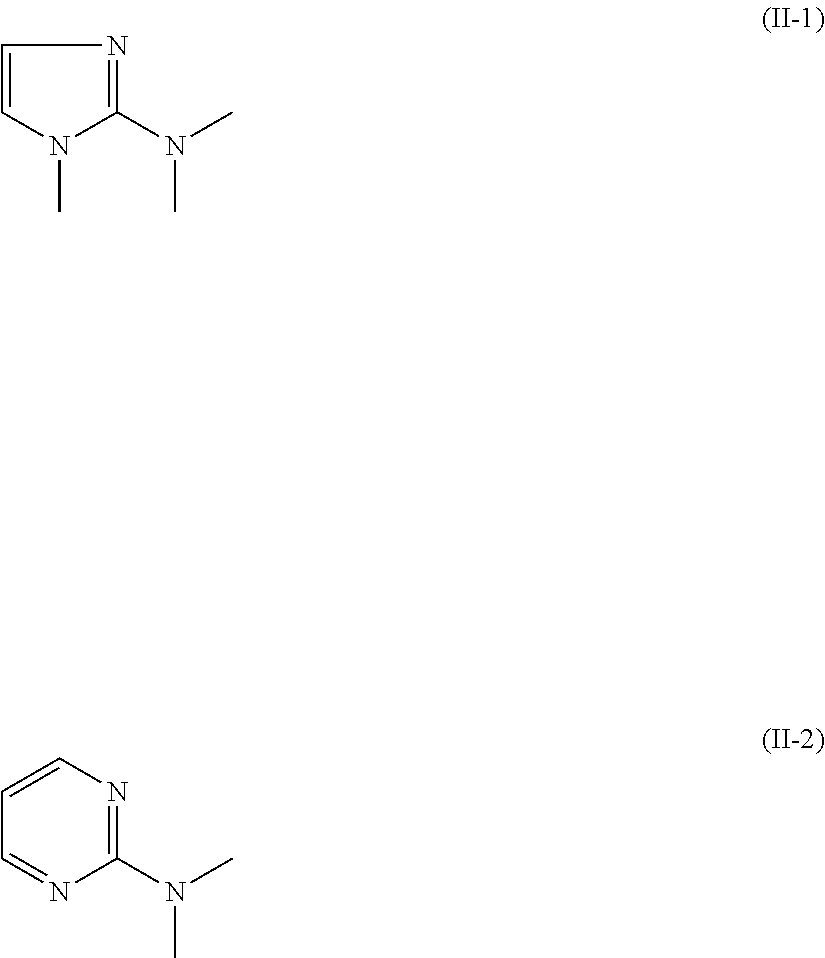Rubber composition, and pneumatic tire using same
a technology of rubber composition and rubber slurry, which is applied in the direction of special tyres, heavy duty tyres, transportation and packaging, etc., can solve the problems of reducing affecting increasing the viscosity of unvulcanized rubber composition, so as to improve the abrasion resistance of tread rubber, improve the abrasion resistance of rubber, and improve the abrasion resistance of a
- Summary
- Abstract
- Description
- Claims
- Application Information
AI Technical Summary
Benefits of technology
Problems solved by technology
Method used
Image
Examples
production example 1
[0190]80 mL of chloroform and 13.8 g of thionyl chloride were added to 10.3 g of 2-(2-hydroxyethylamino)benzimidazole, and heated under reflux for 6 hours. Through reduced-pressure distillation, obtained was 17.3 g of a chloroethyl form product. 60 mL of water and 8.7 g of thiourea were added to 15.1 g of the resultant chloroethyl form product, heated at 90° C. and reacted for 1 day. 30 mL of aqueous 3 N sodium hydroxide solution was added thereto and reacted for 30 minutes, and then cooled to room temperature. The insoluble matter was filtered away, and 50 mL of water and 1.0 g of 35% hydrogen peroxide water were added to the filtrate. The precipitate was deliquored and dried under reduced pressure to give 7.99 g of N,N′-di-(1H-benzimidazol-2-yl)-2,2′-disulfanediylethanamine, the compound a represented by the above-mentioned formula (IV).
[0191]Property: white solid
[0192]Melting Point: 240° C.
[0193]1H-NMR (500 MHz, DMSO-D6, δ ppm): 3.0 (t, 2H), 3.6 (t, 2H), 6.9 (m, 3H), 7.1 (d, 2H),...
production example 2
[0194]In an argon atmosphere, 37.8 g of 1-tert-butoxycarbonyl-2-aminobenzimidazole and 160 ml of dewatered tetrahydrofuran were put into a reactor, and 0.4 g of 4-dimethylaminopyridine were added to the resultant suspension. After this was cooled to 0° C., 3,3′-dithiobis(propionyl chloride) 8 g / dewatered toluene 8 ml was gradually and dropwise added thereto, then restored to room temperature, and thereafter heated under reflux for 3 hours. The reaction liquid was concentrated to ½, then the starting compound, 1-tert-butoxycarbonyl-2-aminobenzimidazole was filtered away, and 150 ml of ethyl acetate was added to the filtrate. This was processed for liquid-liquid separation with 200 ml of water and 150 ml of saturated saline water, then dried with magnesium sulfate, filtered, and concentrated to give a yellow solid. One g / 10 ml of tetrahydrofuran and 10 equivalents (relative to the crude matter as converted into the corresponding product) of tetrafluoroacetic acid were added to the res...
production example 3
[0198]13.3 g of 2-aminobenzimidazole and 100 ml of dewatered tetrahydrofuran were cooled with ice, then 6.17 g of 3,3′-dithiobispropionyl chloride (88.9% by mass) was gradually and dropwise added thereto, restored to room temperature, and stirred for 2 hours. 500 ml of water was dropwise added for crystallization, and the resultant crystal was collected through filtration, crushed and washed with 40 ml of acetone, the crystal was again collected through filtration and dried under reduced pressure at 40° C. to give 8.66 g of bis[3-(2-amino-1H-benzimidazol-1-yl)-3-oxopropyl]disulfane, the compound c represented by the above-mentioned formula (VI).
[0199]Property: white solid
[0200]Melting Point: 228° C.
[0201]1H-NMR (500 MHz, DMSO-D6, δ ppm): 3.2 (t, 4H), 3.6 (t, 4H), 7.0 (t, 2H), 7.2 (t, 2H), 7.2 (d, 2H), 7.4 (brs, 4H), 7.6 (d, 2H)
PUM
| Property | Measurement | Unit |
|---|---|---|
| temperature | aaaaa | aaaaa |
| boiling point | aaaaa | aaaaa |
| nitrogen adsorption specific surface area | aaaaa | aaaaa |
Abstract
Description
Claims
Application Information
 Login to View More
Login to View More - R&D
- Intellectual Property
- Life Sciences
- Materials
- Tech Scout
- Unparalleled Data Quality
- Higher Quality Content
- 60% Fewer Hallucinations
Browse by: Latest US Patents, China's latest patents, Technical Efficacy Thesaurus, Application Domain, Technology Topic, Popular Technical Reports.
© 2025 PatSnap. All rights reserved.Legal|Privacy policy|Modern Slavery Act Transparency Statement|Sitemap|About US| Contact US: help@patsnap.com



